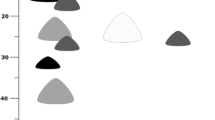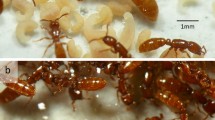Summary
-
1.
Dissections of 49 entire Nasutitermes corniger (Motschulsky) colonies collected in Panama immediately prior to the nuptial flights give data on numbers, biomass and sex ratio of alates produced by individual colonies.
-
2)
Twenty-six other colonies were collected and dissected in the early period of alate nymph development. Alate nymphs proceed through five instars, spending 5–8 months within the parental colony.
-
3)
Even when comparing colonies of similar size, variation in reproductive output among N. corniger colonies in a population is marked. Mature colonies (neuter population size 50,000–400,000) generally produce 5,000–25,000 alates, although some large colonies had no fertile brood, at least during the year they were censused.
-
4)
On average, colonies which produce alates have 35% of the colony biomass invested in alates (or late instar nymphs) shortly before the nuptial flight.
-
5)
Female N. corniger alates are 1.2–1.4 times heavier (dry weight) than male nestmates. Numerical sex ratio among colonies is skewed toward males, while biomass “investment” sex ratio is not significantly different from 1:1. These data conform to Fisher's amended theory of expected sex ratio.
Similar content being viewed by others
References
Bouillon A (1964) Etude de la composition des sociétiés dans trois especes d'Apiotermes Holmgren. In Bouillon A (ed). Etudes sur les Termites Africanis. Masson, Paris, pp 181–196
Brian MV, Elmes G, Kelly AF (1967) Populations of the ant Tetramorium caespitum Latreille. J Anim Ecol 36:337–342
Coaton WGH (1949) Queen removal in termite control. Farming S Africa 14:335–338
Cohen D (1966) Optimizing reproduction in a randomly varying environment. J Theor Biol 12:119–129
Cohen D (1967) Optimizing reproduction in a randomly varying environment when a correlation may exist between the conditions at the time a choice has to be made and a subsequent outcome. J Theor Biol 16:1–14
Cohen D (1968) A general model of optimal reproduction in a randomly varying environment. J Ecol 56:219–228
Collins NM (1981) Populations, age structure and survivorship of colonies of Macrotermes bellicosus (Isoptera: Macrotermitinae). J Anim Ecol 50:293–311
Darlington JPEC (1977) Observations on flight patterns and other characteristics of Macrotermes nests. I.C.I.P.E. 5th Annual Reprot 28-29
Darlington JPEC (1978) Populations of nests of Macrotermes species in Kajiado and Bissell. I.C.I.P.E. 6th Annual Report, pp 22–23
Dietz HF, Snyder TE (1923) Biological notes on the termites of the Canal Zone and adjoining parts of the Republic of Panama. US Dept Agricul J Agric Res 26:279–302
Dudley PH, Beaumont J (1890) Termites of the Isthmus of Panama Part II. Trans NY Acad Sci 9:157–180
Fisher RA (1929) The Genetical Theory of Natural Selection. Rev 1958. Dover Press, New York
Harms, JW (1927) Koloniegründung bei Macrotermes gilvus Hag. Zool Anz 74:221–236
Kolman W (1960) The mechanism of natural selection for the sex ratio. Am Nat 94:373–377
Lüscher M (1961) Social control of polymorphism in termites. In: JS Kennedy (ed). Insect Polymorphism. Roy Ent Soc, London. pp 57–67
Mountford MD (1971) Population survival in a variable environment. J Theor Biol 32:75–79
Mountford MD (1973) The significance of clutch size In: Bartlett MS, Hiorns RW (eds) The Mathematical Theory of the Dynamics of Biological Populations. Academic Press, New York, pp 315–323
Nielsen MG, Josens G (1978) Production by ants and termites. In: Brian MV (ed) Production Ecology of Ants and Termites. Cambridge Univ. Press, Cambridge, England, pp 45–53
Noirot C (1956) Les sexués de remplacement chez les Termites supérieurs (Termitidae). Ins Sociaux 3:145–158
Nutting WL (1969) Flight and colony foundation. In: Krishna K, Weesner FM (eds) Biology of Termites. Academic Press, New York, pp 233–282
Nutting WL, Haverty MI (1976) Seasonal production of alates by five species of termites in an Arizona desert grassland. Sociobiology 2:145–153
Nutting WL (1979) Termite flight periods: strategies for predator avoidance? Sociobiology 4:141–151
Roonwal ML (1975) Sex ratios and sexual dimorphism in termites. J Scient Ind Res 34:402–416
Sands WA (1965) Mound population movements and fluctuation in Trinervitermes ebenerianus Sjöstedt (Isoptera, Termitidae, Nasutitermitidae). Ins Sociaux 12:49–58
Schaffer WM (1974) Optimal reproductive effort in fluctuating environments. Amer Nat 108:783–790
Thorne BL (1980) Differences in nest architecture between the Neotropical arboreal termites Nasutitermes corniger and Nasutitermes ephratae (Isoptera: Termitidae). Psyche 87:235–243
Thorne BL (1982a) Polygyny in termites: multiple primary queens in colonies of Nasutitermes corniger (Motschulsky) (Isoptera: Termitidae). Ins Sociaux 29:102–117
Thorne BL (1982b) Reproductive plasticity in the Neotropical termite Nasutitermes corniger. In: Jaisson P (ed) Social Insects in the Tropics. Université Paris-Nord, Paris, pp 21–29
Thorne BL (1982c) Multiple primary queens in termites: phyletic distribution, ecological context, and a comparison to polygyny in Hymenoptera. In: Breed MD, Michener CD, Evans HE (eds) The Biology of Social Insects. Westview Press, Boulder, Colorado
Thorne BL (1983) Population dynamics and reproductive biology of Neotropical Nasutitermes (Isoptera; Termitidae). PhD thesis, Harvard University, Cambridge, Mass
Thorne BL, Noirot C (1982) Ergatoid reporductives in Nasutitermes corniger (Motschulsky) (Isoptera: Termitidae). Int J Insect Morph Embryol 11:213–226
Warren E (1909) Notes on the life histories of Natal termites, based on observations of the late G.D. Haviland. Annals Natal Museum Vol II, Pt 1, pp 113–128
Author information
Authors and Affiliations
Rights and permissions
About this article
Cite this article
Thorne, B.L. Alate production and sex ratio in colonies of the Neotropical termite Nasutitermes corniger (Isoptera; Termitidae). Oecologia 58, 103–109 (1983). https://doi.org/10.1007/BF00384548
Received:
Issue Date:
DOI: https://doi.org/10.1007/BF00384548




